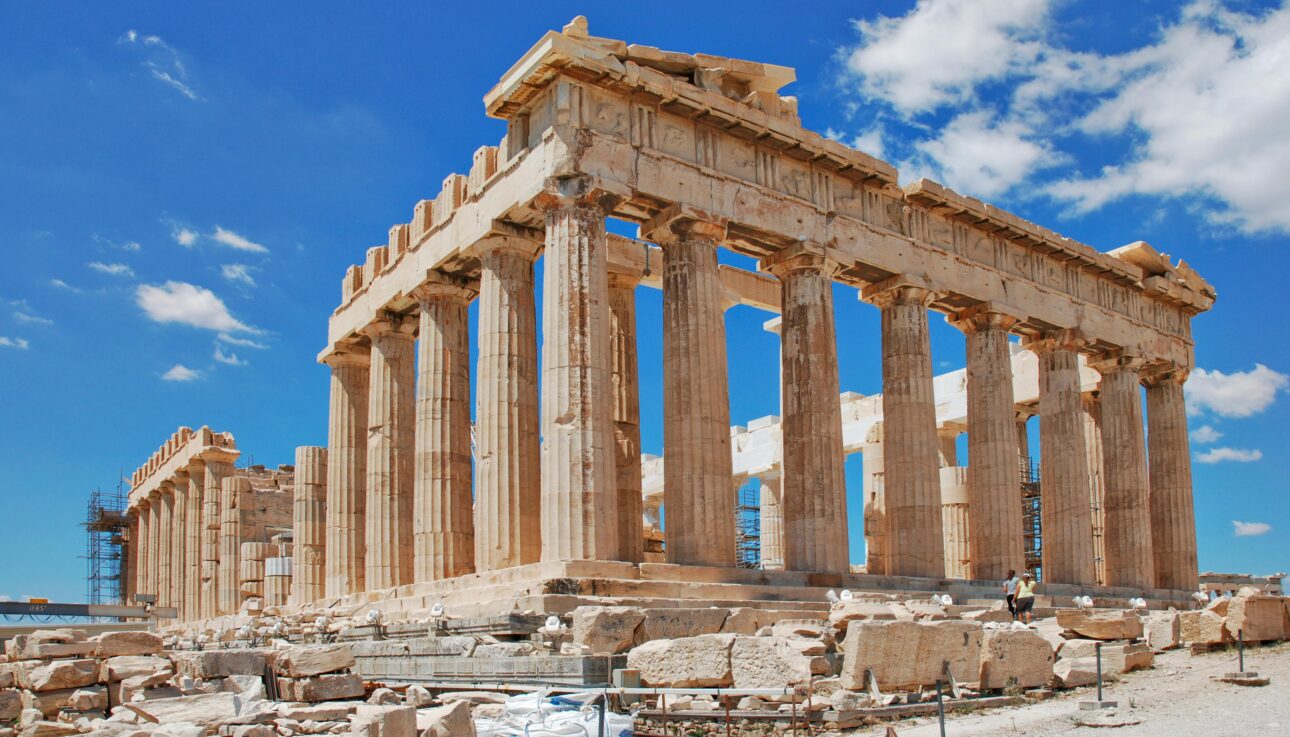1. The Acropolis of Athens
Why It’s a Must-See:
The Acropolis of Athens is arguably the most iconic archaeological site in Greece. Perched high on a rocky hill, this ancient citadel is home to some of the most important monuments of classical Greece, including the Parthenon, the Erechtheion, and the Temple of Athena Nike. The Acropolis was the center of ancient Athens and a symbol of the city’s power and culture. A visit to the Acropolis offers breathtaking views of Athens and a profound connection to the ancient world.
Highlights:
- The Parthenon: Dedicated to the goddess Athena, this temple is a masterpiece of Doric architecture and a symbol of ancient Greek civilization.
- The Erechtheion: Known for its Caryatids, the iconic female figures that serve as columns, this temple has a unique and intricate design.
- The Acropolis Museum: Just a short walk from the site, this museum houses many of the artifacts found on the Acropolis, offering deeper insight into its history.
2. Delphi
Why It’s a Must-See:
Located on the slopes of Mount Parnassus, Delphi was once considered the center of the world in ancient Greek religion. The site was home to the Oracle of Delphi, where pilgrims from across the Greek world would come to seek advice from the god Apollo. The ruins of Delphi include the Temple of Apollo, a theater, a stadium, and various treasuries built by different city-states. Delphi’s dramatic setting, with its stunning views of the surrounding valley, adds to the mystical allure of the site.
Highlights:
- The Temple of Apollo: The heart of the sanctuary, where the Oracle would deliver her prophecies.
- The Ancient Theater: Offering panoramic views of the valley below, the theater was used for musical performances and plays.
- The Delphi Archaeological Museum: This museum contains some of the most important artifacts from the site, including the famous Charioteer of Delphi.
3. Knossos, Crete
Why It’s a Must-See:
Knossos, located near Heraklion on the island of Crete, is the largest Bronze Age archaeological site in Greece and is considered Europe’s oldest city. It was the political and ceremonial center of the Minoan civilization, which flourished around 2000-1400 BCE. The Palace of Knossos is the most significant structure on the site, known for its complex layout, vibrant frescoes, and the myth of the Labyrinth and the Minotaur. Exploring Knossos offers a fascinating look at Minoan culture and its influence on later Greek civilizations.
Highlights:
- The Throne Room: A chamber with a stone throne, believed to be the oldest in Europe, surrounded by stunning frescoes.
- The Frescoes: Vibrantly colored wall paintings depicting Minoan life, including the famous “Bull-Leaping” fresco.
- The Labyrinth Myth: The site is closely linked to the legend of King Minos, the Minotaur, and the Labyrinth, adding a layer of mythological intrigue.
4. Olympia
Why It’s a Must-See:
Olympia, located in the Peloponnese, is the birthplace of the Olympic Games, one of the most significant cultural events in ancient Greece. The site was a major religious and athletic center, where athletes from all over the Greek world would come to compete in honor of Zeus. The ruins of Olympia include the remains of the massive Temple of Zeus, the ancient stadium, and the Gymnasium. The site is a powerful reminder of the enduring legacy of the Olympic spirit and its role in promoting unity and peace.
Highlights:
- The Temple of Zeus: Once home to one of the Seven Wonders of the Ancient World—the Statue of Zeus, a massive gold and ivory figure created by Phidias.
- The Ancient Stadium: Where the Olympic Games were held, with seating for thousands of spectators.
- The Archaeological Museum of Olympia: Houses the Hermes of Praxiteles, one of the most exquisite sculptures from ancient Greece.
5. Mycenae
Why It’s a Must-See:
Mycenae, located in the northeastern Peloponnese, was the center of the Mycenaean civilization, which dominated mainland Greece during the late Bronze Age. The site is associated with the legendary King Agamemnon, leader of the Greeks in the Trojan War. The ruins of Mycenae include the famous Lion Gate, the royal palace, and the beehive-shaped tombs known as tholos. Mycenae’s importance in Greek mythology and history makes it a fascinating destination for those interested in the roots of ancient Greek culture.
Highlights:
- The Lion Gate: The main entrance to the citadel, featuring two carved lions that are among the oldest monumental sculptures in Europe.
- The Treasury of Atreus: Also known as the Tomb of Agamemnon, this impressive tholos tomb is a marvel of ancient engineering.
- The Grave Circles: Containing the richly adorned tombs of Mycenaean royalty, where the famous gold “Mask of Agamemnon” was discovered.
6. Epidaurus
Why It’s a Must-See:
Epidaurus, located in the Peloponnese, was a major center of healing in the ancient world, dedicated to Asclepius, the god of medicine. The site is most famous for its ancient theater, which is renowned for its exceptional acoustics and is still used for performances today. The sanctuary of Asclepius attracted pilgrims seeking cures for their ailments, and the ruins include temples, baths, and other facilities related to the healing cult. Epidaurus offers a unique combination of cultural, religious, and medical history.
Highlights:
- The Ancient Theater of Epidaurus: Considered one of the best-preserved ancient theaters in Greece, it seats up to 14,000 people and is known for its incredible acoustics.
- The Sanctuary of Asclepius: The centerpiece of the site, where ancient Greeks would come to be healed by the god of medicine.
- The Archaeological Museum of Epidaurus: Displays artifacts related to the healing practices and religious activities at the site.
7. Delos
Why It’s a Must-See:
Delos, a small island in the Cyclades, is one of the most important mythological, historical, and archaeological sites in Greece. According to Greek mythology, Delos was the birthplace of Apollo and Artemis, making it a sacred island. The ruins of Delos include temples, theaters, and the famous Terrace of the Lions, where stone lion statues stand guard over the ancient sacred way. Delos offers a fascinating insight into the religious and commercial life of ancient Greece, and its remote location adds to the mystique of the site.
Highlights:
- The Terrace of the Lions: A row of marble lion statues that once lined the sacred way leading to the sanctuary of Apollo.
- The House of Dionysus: A well-preserved example of an ancient Greek house, featuring stunning mosaics depicting scenes from mythology.
- The Archaeological Museum of Delos: Contains a rich collection of artifacts discovered on the island, including statues, pottery, and inscriptions.
Wrap-Up: A Journey Through Ancient Greece
Exploring Greece’s archaeological sites is like stepping back in time to an era when gods and heroes walked the earth. Each site offers a unique window into the past, revealing the rich cultural and historical tapestry of ancient Greece. Whether you’re marveling at the grandeur of the Acropolis, walking in the footsteps of athletes at Olympia, or uncovering the secrets of the Minoans at Knossos, these ancient ruins are a must-see for any traveler. As you journey through these sites, you’ll gain a deeper appreciation for the enduring legacy of Greece’s ancient civilizations and their contributions to the world.









